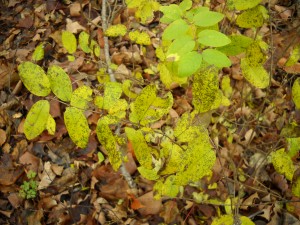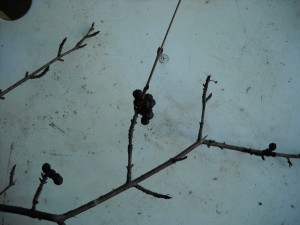Getting Rid of Invasives
There are still a few nice days left before cold rain, snow and cold take over our weather systems, and I try to take advantage of these last warm, sunny days. Unfortunately, I’m not the only one. No, I hope you do, too. It’s those pesky, unwanted invasive shrubs in the understory of our woods and forests that I am referring to. I took a walk recently and noticed that there are plenty of bush honeysuckles enjoying the sunshine. Many still have green leaves (some are turning yellow now), allowing them to make energy by photosynthesis and store it for winter.
Go for a walk along a country road or into your woods. If you see bushy shrubs that still have green leaves,
you are probably seeing Amur honeysuckle (Lonicera maackii). This bush honeysuckle is able to grow in sun or shade, wet or dry. It is one of the first plants to get leaves in the spring, one of the last to lose them in fall. It shades out our native wildflowers and other native shrubs. It is taking over the landscape – but you can help control it now, when you don’t have so many other gardening tasks to occupy your time.
Amur honeysuckle can get to be12-15 feet tall and wide. It is a floppy plant with yellowish-white blossoms in June and quarter-inch diameter red berries. Birds eat the seeds and then distribute them in their droppings. It takes 3-5 years from germination to the time a honeysuckle produces flowers and berries.
The roots of this bush honeysuckle tend to be quite close to the surface of the soil, so pulling or digging them out is not very difficult. I recently spent part of a morning working to eliminate honeysuckle on my property. Here is what I found.
Pulling small to medium sized honeysuckles does not require superhuman strength. I easily pulled shrubs that were 3 to 5 feet tall and wide. Larger specimens I just cut to the ground. Yes, they may re-sprout, come spring, but they won’t bloom and produce seeds next year. If I can go back each year and cut off new shoots, I will prevent the plant from spreading.
I recently spoke to Kari Asmus of Hanover, NH who has been digging up invasive plants on her property since she and her husband bought it 11 years ago. She recommends using a “weed wrench” for pulling medium to large sized honeysuckles, along with two small tree species, the glossy buckthorn (Rhamnus frangula) and common buckthorn (Rhamnus cathartica) which are also invasive species on their property. A weed wrench (www.weedwrench.com) is a hand tool that gives you a nice mechanical advantage: it grabs onto a stem down low, and has a long handle to help you to pry out the root system with minimal effort.
Kari’s property is about 10 acres, and by keeping after the invasive plants each year, she has reduced their incidence to a point where they are not a problem. Native plants like bloodroot and wild ginger – absent when they bought the property – have returned and spread through their woods. Kari said fall and spring are the times to work on digging out problem plants. They have leaves when native plants do not. She said she has gotten to recognize the distinctive color of the leaves, even from a distance, so she can go right to a honeysuckle or buckthorn to pull it out. Seeds deposited years ago continue to germinate, but the young plants are easy to pull by hand.
The buckthorns get bigger than honeysuckles and are more difficult to eliminate. Although a honeysuckle,
if cut down, may send up new shoots at the stump, it does not send up root suckers the way a buckthorn will. Root suckers are new shoots coming up from the roots that develop into full-size trees; they can pop up 10 feet or more from the parent tree. They are a stress response by certain trees: if cut down (or sometimes if they are infected with a lethal fungus), shoots develop.
Nelia Sargent of Claremont, NH taught me some years ago how to kill buckthorns without stimulating root suckers. She double girdles a buckthorn by cutting all the way around the trunk with a hand saw. She just cuts through the green cambium layer of bark, but does not cut into the heartwood. Then she goes up 12 inches and does it again. She said it takes 3 years to kill the tree but no suckers are sent up. I tried it on a neighbor’s tree, and, by golly, it worked. However, the common buckthorn often has a trunk that can make it difficult to double girdle the tree: there are often up to a dozen trunks growing very closely together.
In my neighborhood the buckthorns have already lost their leaves, but the trees are loaded with dark berries, just waiting for hungry birds to come this winter for food. Each berry has 3-4 hard seeds, just waiting by be dropped somewhere so it can start a new tree.
So if you are looking for a good project on the next sunny day, go look for invasives and see if you can get rid of a few.
Henry Homeyer can be reached by e-mail at henry.homeyer@comcast.net or by mail at P.O. Box 364, Cornish Flat, NH 03746. His Web site is www.Gardening-Guy.com




